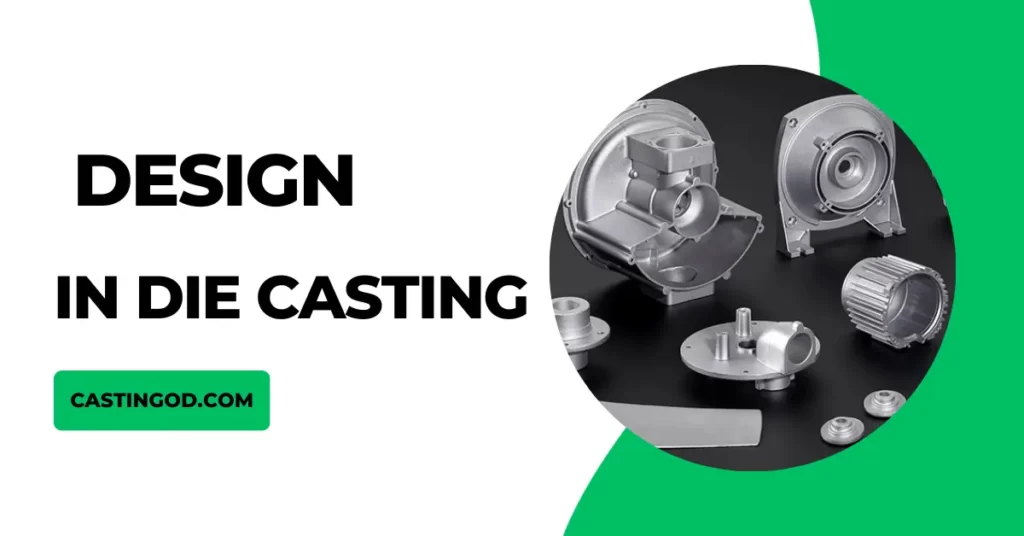Die casting is a critical process in manufacturing die cast parts. Similarly, it helps in understanding how to design die cast components. Ultimately, this method can significantly impact product cost and quality.
In this article, we’ll explore key principles for optimizing die casting designs and achieving the best possible outcomes.
In addition, we shall try to figure out what makes a design suitable for die casting.
The Role of Design in Die Casting

Design plays a pivotal role in the cost and quality of a product. In fact, 70% of the cost and 80% of quality problems are often inherent to the design itself. Understanding the die casting process is crucial to creating designs suitable for this method.
Today’s discussion will cover general design principles in die casting manufacturing process. These concepts can be further developed through interactions with your local die casters. We will explore what distinguishes a good die casting design from a suboptimal one.
The outline for today’s presentation includes optimizing geometry, secondary operations, and prototyping. These steps are essential for creating designs that are easy to die cast.
Optimizing Geometry
Optimizing the geometry of a component is a crucial step in die casting projects. This involves understanding features such as draft angles, parting lines, bosses, ribs, holes, and windows. Achieving uniform wall thickness is vital, as significant variations can lead to porosity and defects.
Draft in Die Casting Design
Adding draft to components is essential to ensure smooth die opening and casting ejection. Proper draft angles prevent damage to the casting and the formation of drag marks. It improves the casting’s surface quality and extends the lifespan of the die.
Precision Level Draft Analysis
Distinguishing between standard and precision draft levels is essential, especially for high-performance applications. The choice of draft level impacts the ease of die casting and the quality of the final product.
Draft Analysis for Improved Design
Draft analysis aids in identifying parting lines and predicting flash formation, which occurs where parting lines exist. Early draft analysis is beneficial for designers to optimize designs before engaging with die casters.
In close collaboration with our customers, our R&D team at Castingod starts with the very first concept and early-stage development. This includes the product design, the material, and the process optimization. The serial production is planned very carefully and individually for each product. The special requirements and properties of each component are taken into account.
Castingod aluminum die casting services manufactures following parts:
Our in-house tool shop allows seamless interaction between our R&D and our casting experts. At Castingod, we have fully equipped tool-making workshops in China. The casting process in the foundry starts with molten aluminum or magnesium alloys.
At the die casting cell, the molten metal alloy is shot into the closed halves of the die casting tool with extremely high pressure.
Aluminum Die Casting Process At Castingod
Already during the development process, component properties and production processes are optimized in simulation rounds. After each shot, the moving half of the tool slides away fully automated within the die casting cell.
The still very hot casting is taken out by a robot while the tools are prepared for the next shot. The casting is cooled down and prepared for the trimming process where the feeding systems and burrs are cut away. The precision of the step is crucial for the quality of the part.
Each part is engraved with a data matrix code. It allows full traceability of the part throughout the whole production process. Automated guided vehicles help with intelligent interlogistics tasks on site.
To optimize the properties of structural parts, heat treatment is applied. GF Casting Solutions is equipped with the latest technology at all of our respective foundries.
Temperature and Mold Duration in die Casting
Duration and temperature need to be chosen with care as it affects directly the component’s properties. All parts can be machined in-house to reduce logistics and shorten the quality loops.
Through coding and passivation, the component surfaces are additionally protected against corrosion. All process steps are tracked and archived in connection with a data matrix code of the part.
The dimensions and properties of the components are measured and confirmed to ensure all requirements demanded by the customer are met. In our master control station, all process steps are connected and can be controlled centrally. Already slight deviations can be detected early on to prevent further issues in the production process.
The more data is available and collected in real-time, the better the reaction times and maintenance will be. In addition, based on the collected production data, parameters and correlations are visualized and analyzed to further improve the overall process. This happens in real-time and even remotely during all process steps.
Conclusion
Designing for die casting is a nuanced process that significantly influences product cost and quality. By understanding the principles of optimizing geometry, draft angles, and draft analysis, designers can contribute to the success of the die casting process.
With these revisions, the article provides a concise and organized overview of optimizing die casting designs for efficiency and quality.
From the first design until the ready-to-mount solution, our strong focus is on availability, performance, and quality. To guarantee a high overall equipment efficiency in all our plants globally, in our strategy 2025, we have defined operational excellence as one of our strategic focus areas.
We can execute cost effective die casting projects. For instance, we can manufacture complex shapes die cast components with excellent surface finishing.











